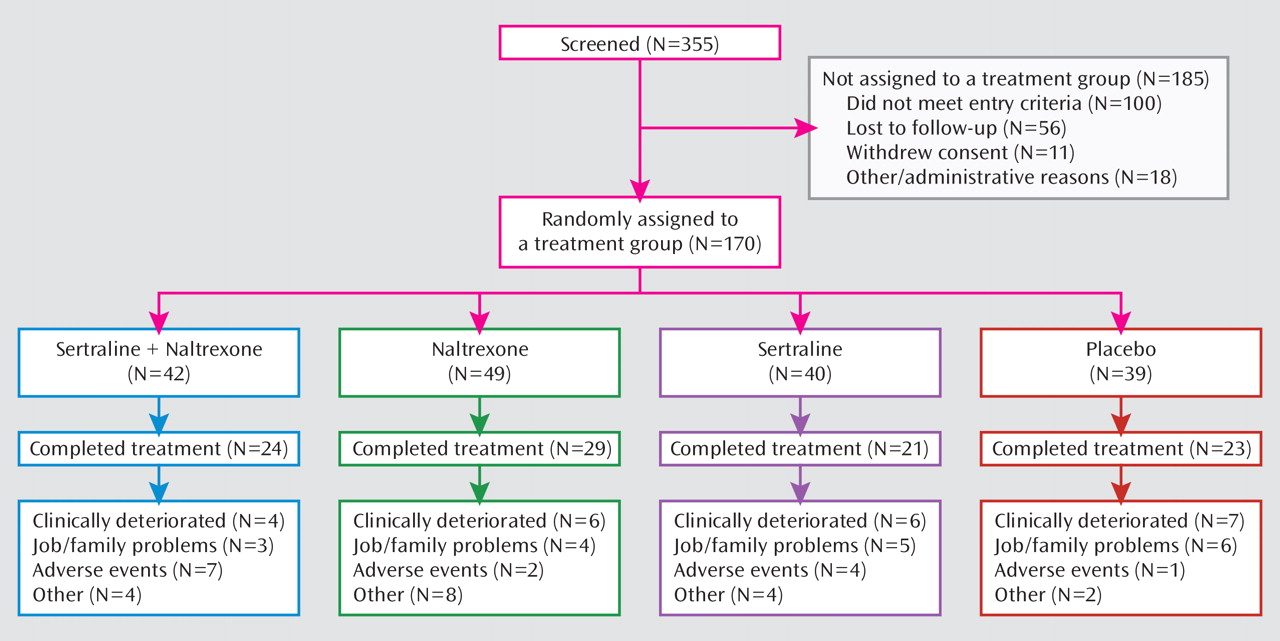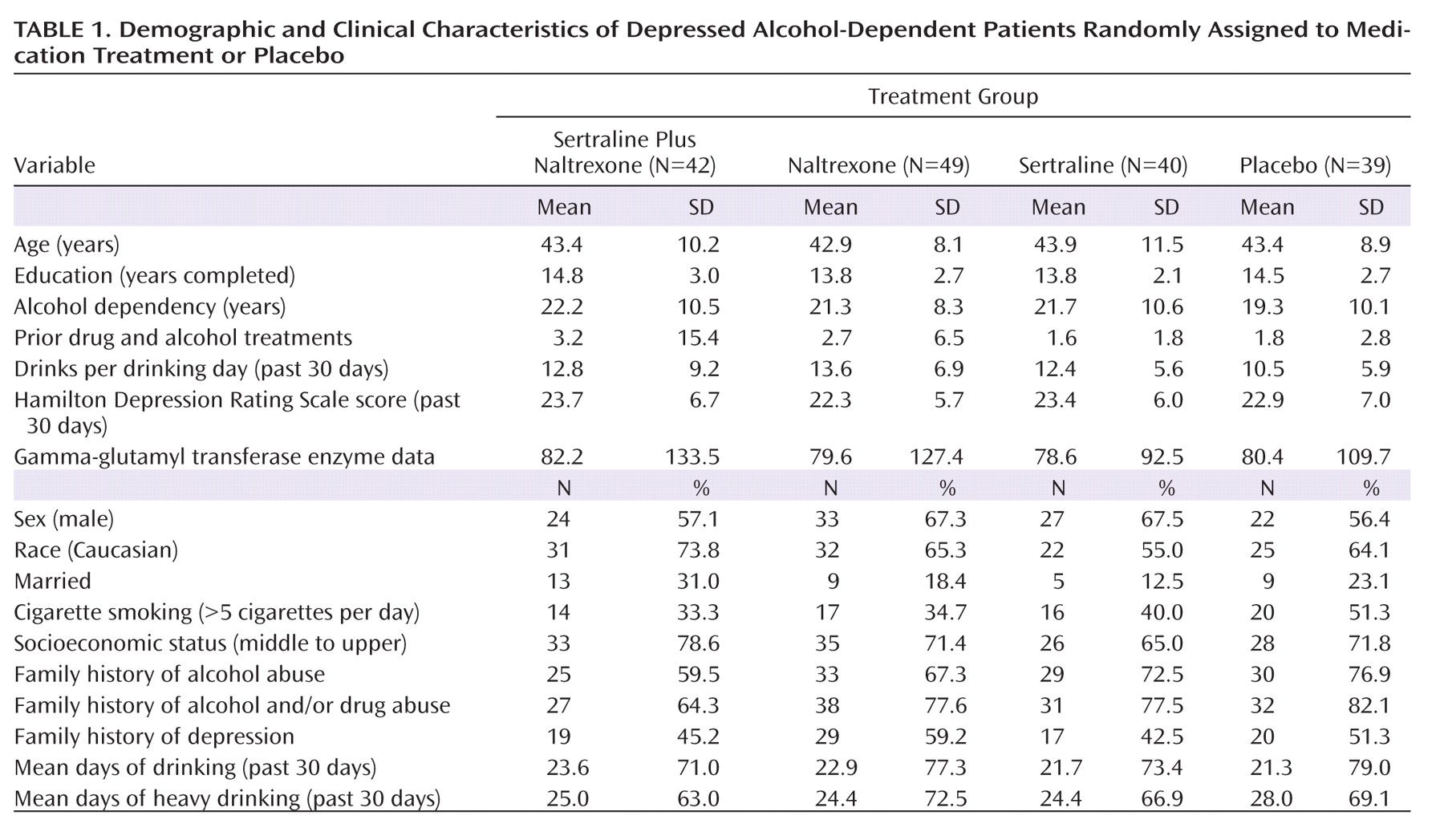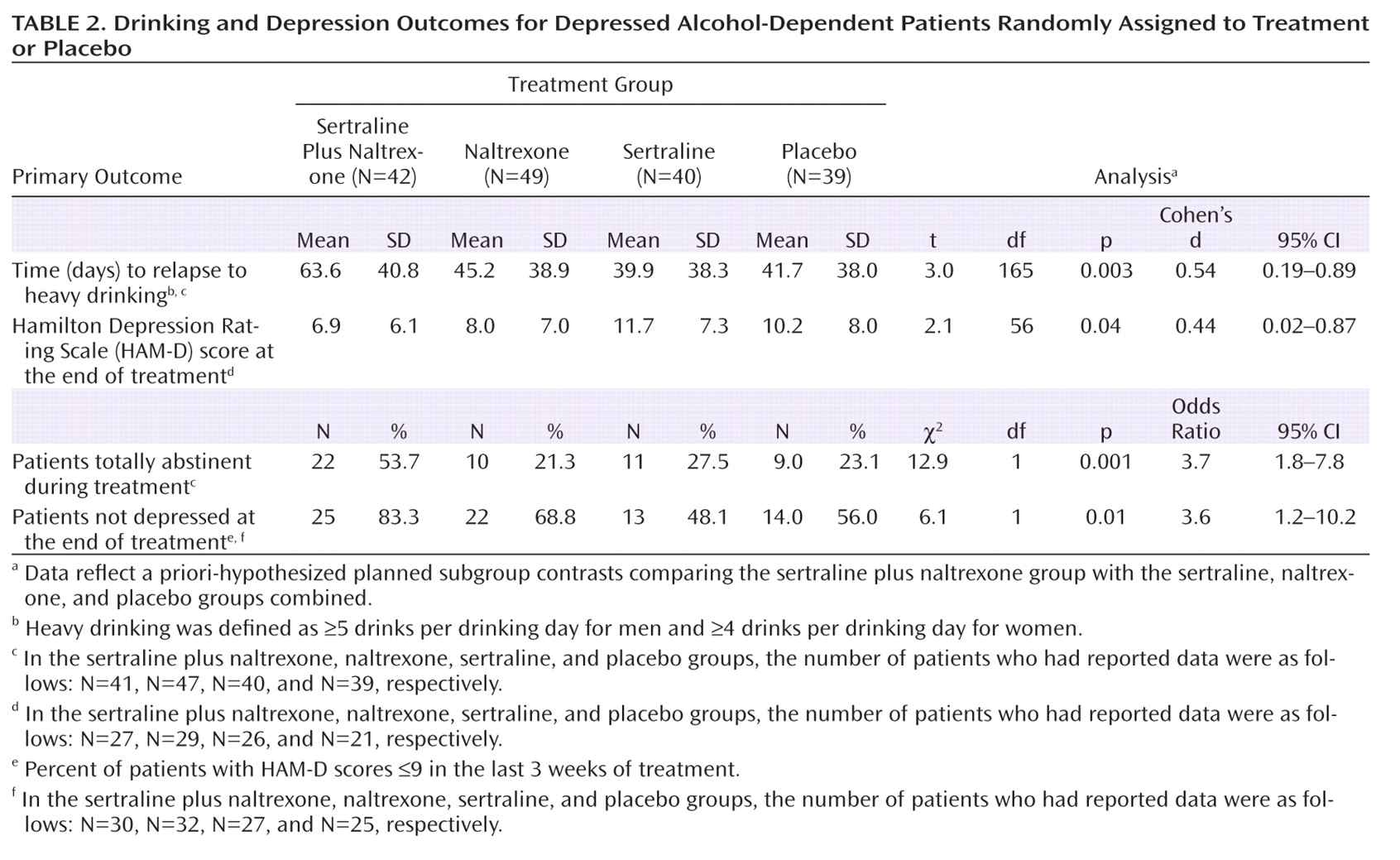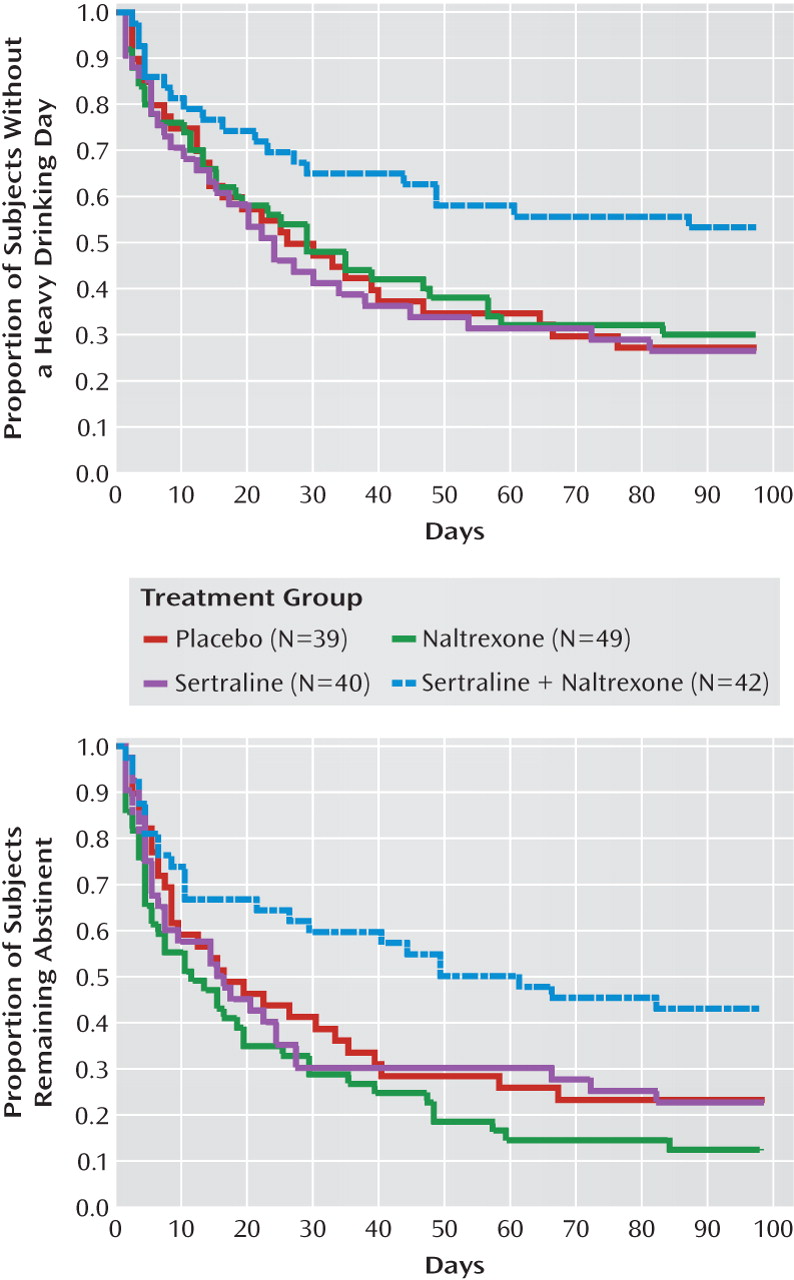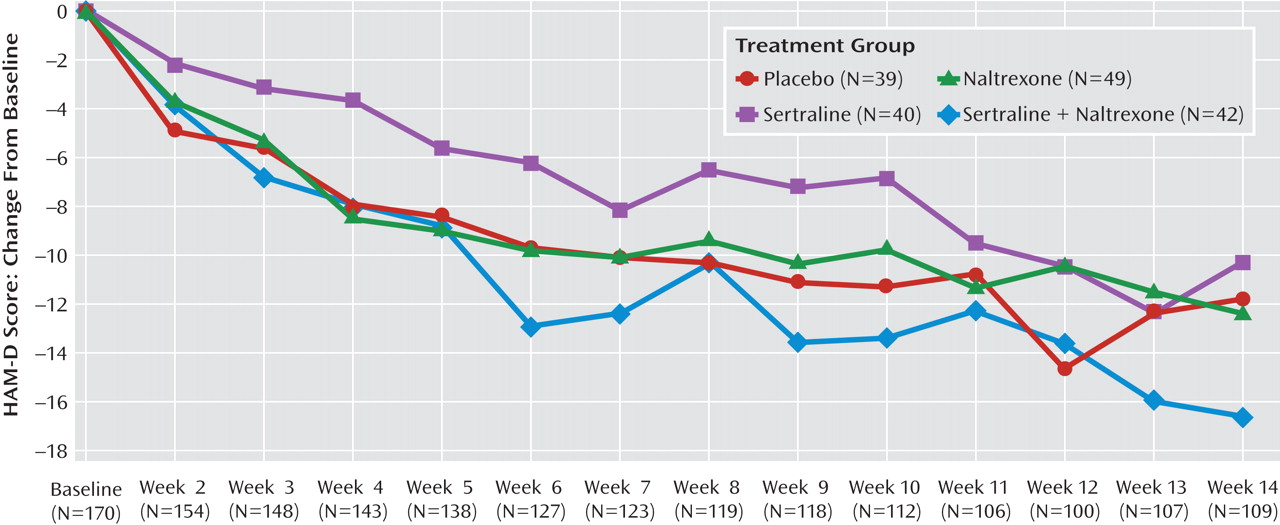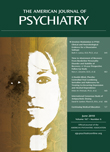Empirical data that support effective pharmacotherapy for the frequent combination of depression and alcohol dependence are long overdue (
1–
3). Each disorder carries a significant risk for the development of the other (
2–
5), and high severity in one disorder is associated with high severity in the other (
4,
5). Alcohol dependence prolongs the course of depression (
6,
7), and the persistence of depression during abstinence from alcohol is a risk factor for relapse to heavy drinking (
6,
8–
10). Thus, logic dictates that both disorders should be identified and managed when treating patients.
Antidepressant Treatment for Depressed Patients With Alcohol Dependence
Empirical evidence for the efficacy of the use of antidepressants for alleviating depressive symptoms in depressed alcohol-dependent patients is limited, and results are contradictory across the few existing studies. That is, there are fewer than one dozen well-controlled antidepressant trials with depressed alcohol-dependent patients, and only one is a large multisite study (
11). Findings from the multisite trial revealed that a selective serotonin reuptake inhibitor (SSRI), sertraline (50–150 mg/day for 10 weeks), provided no advantage over placebo in reducing depressive symptoms, nor did it reduce drinking. This finding challenged two independent reviews of the other controlled trials, which reported that antidepressants alleviated depression but had little effect on reducing drinking (
12,
13). Pettinati's (
13) review of the controlled studies concluded that an antidepressant alleviated depressive symptoms in 75% of the studies but reduced drinking in only 38%.
Treating Depressed and Alcohol-Dependent Patients With Combination Medications
Because antidepressants do not appear to affect drinking in depressed alcohol-dependent patients, a medication that directly affects drinking may be necessary for successful treatment. In an open-label study (
14), 14 depressed alcohol-dependent patients were given naltrexone (50 mg/day), added to treatment with an SSRI. After 12 weeks, these patients decreased their drinking and showed additional mood improvement. One comparable, but placebo-controlled, study did not find an advantage in adding naltrexone to further reduce drinking in 74 sertraline-treated depressed, alcohol-dependent older adults (
15).
The present study is a single-site investigation that evaluated combining two Food and Drug Administration (FDA)-approved medications, sertraline (for depression) and naltrexone (for alcohol dependence), to treat patients with both disorders. An important aim was to compare mood and drinking outcomes of this medication combination with those of placebo and treatment in which each medication was prescribed independently. Sertraline was selected because most controlled studies investigating medications for co-occurring depression and alcohol dependence have prescribed an SSRI. Naltrexone, an opioid receptor antagonist, was selected for targeting drinking because it is well known to reduce heavy drinking in alcohol-dependent patients (
16). We predicted that more patients treated with the medication combination (an opiate antagonist and antidepressant) would achieve complete abstinence, delay relapse to heavy drinking, and show reduced depressive symptoms compared with patients treated with naltrexone, sertraline, or a placebo.
Method
Patients
Patients were 170 men and women, aged 21–75 years, with current DSM-IV diagnoses of major depression and alcohol dependence. Inclusion criteria were 1) consumption of an average of ≥12 alcoholic drinks per week, 2) consumption of an alcoholic drink on ≥40% of the 90 days before treatment, 3) 3 days of consecutive abstinence just before starting treatment, and 4) a Hamilton Depression Rating Scale (HAM-D [
17]) score ≥10 at the time of randomization. Patients were excluded if they had substance dependence besides alcohol or nicotine dependence; had bipolar-affective disorder, schizophrenia, or other psychotic or organic mental disorders; were regularly taking an antidepressant; needed psychiatric medications other than an antidepressant; had a severe medical illness; or were pregnant or breastfeeding. The University of Pennsylvania's Institutional Review Board approved the study, and all patients provided informed consent.
Patient Flow, Screening, and Treatment Initiation
As seen in
Figure 1, a total of 355 patients were screened, and 170 were randomly assigned to one of the following four treatment conditions for 14 weeks: sertraline (200 mg/day) plus naltrexone (100 mg/day) (N=42); naltrexone (100 mg/day) plus placebo (N=49); sertraline (200 mg/day) plus placebo (N=40); or double placebo (N=39). Approximately 43% of patients prematurely discontinued treatment because of the following circumstances: clinical deterioration (13.5%), job or family problems (10.6%), adverse events (8.2%), or other hindrance (10.6%). Clinical deterioration was defined as an escalation of depression and/or drinking necessitating medication and clinical referral. There were no significant differences across groups in reasons for discontinuation (Figure 1).
Patients learned of the study via newspaper advertisements, local professionals, or friends and family and, after an initial telephone screening, were invited for evaluation at the University of Pennsylvania Treatment Research Center, a research-sponsored outpatient substance abuse treatment facility. Consenting patients completed baseline screening (1 week) and a 14-week treatment trial. Urn randomization was used to evenly distribute participants across groups using the following four pretreatment variables: gender, regular smoking (>5 cigarettes per week), HAM-D scores at the time of randomization (10–20 versus ≥21), and drinking frequency (drinking on <68% versus ≥68% of days in the past 90 days).
Treatment included weekly individual cognitive-behavioral therapy (CBT) using the National Institute on Alcohol Abuse and Alcoholism Project MATCH (Matching Alcoholism Treatments to Client Heterogeneity) manual (
18), adapted to also treat depression.
Study medication was dispensed weekly in blister cards. At randomization, patients received 50 mg/day of naltrexone (or placebo) for 4 days, and then an additional 50 mg/day was added to achieve the maximum naltrexone dosage of 100 mg/day. In the next week, 50 mg/day of sertraline (or placebo) was added, and then an additional 50 mg/day was added every third day until the maximum sertraline dosage of 200 mg/day was achieved. Medical clinicians could exercise flexibility in dosing patients who could not tolerate maximum daily doses. Patients continued to receive treatment until week 13, when naltrexone was reduced to 50 mg/day, with sertraline maintained at 200 mg/day. In week 14, naltrexone was continued at 50 mg/day and sertraline was reduced to 100 mg/day. Medications were completed by the last treatment day.
Although the FDA-recommended daily dose of sertraline for the treatment of depression starts at 50 mg/day, we chose a higher target dose (200 mg/day) to allow for maximum therapeutic benefits, since higher SSRI doses have been commonly prescribed in published studies on reducing drinking. Similarly, the FDA-recommended daily dose of naltrexone is 50 mg/day, but we chose a target dose of 100 mg/day because this higher dose was effective in the COMBINE study (Combining Medications and Behavioral Interventions for Alcoholism [
19]), the largest pharmacotherapy study on alcohol dependence. In addition, some preclinical investigations have suggested that naltrexone doses >50 mg/day might result in better outcomes (
20).
Measures
Psychiatrically trained clinicians (with graduate degrees) derived DSM-IV diagnoses using the Structured Clinical Interview for Axis I DSM-IV Disorders–Patient Edition (SCID-P) (
21). The SCID-P is a 60-minute semistructured interview that yields current and lifetime DSM-IV axis I diagnoses based on patient responses and clinician judgment. For the present study, patients had to have at least 1) three out of seven alcohol dependence symptoms in the past year, with evidence of alcohol dependence in the past month, and 2) five out of nine depression symptoms for 2 weeks in the past month, with one symptom being depressed mood or loss of interest or pleasure. We primarily targeted alcohol-dependent patients with major or independent depression. Independent depression is less common than substance-induced depression with alcohol dependence (
22) and less likely to dissipate with abstinence (
23). In addition, patients with independent depression are more likely to respond to antidepressant treatment, although some studies have reported that prognoses with pharmacotherapy can be similar when patients with independent depression are compared with patients with substance-induced depression (
24,
25). Additional SCID-P questions were asked in order to determine whether a patient's depression was independent or substance-induced.
A medical practitioner completed the medical history, physical examination, and pretreatment laboratory testing for each patient. Breathalyzer readings were conducted at each visit to ensure that data were collected when patients were abstinent. Adverse events were measured using the Systematic Assessment for Treatment Emergent Effects (
26).
The Addiction Severity Index (
27), a 45-minute semistructured interview, was conducted at the screening visit to collect demographic and clinical data before patients received treatment.
We used the 24-item symptom-based HAM-D as the depression outcome measure. This semistructured interview was conducted by a psychiatrically trained clinician (with a graduate degree). HAM-D scores were determined on the day of randomization and weekly during the trial.
The measure we used to assess drinking outcome was the Alcohol Timeline Followback method (
28). This is a semistructured interview that uses memorable life events and a personalized calendar to prompt recall of drinking quantities per day over a specified time period, which was up to 90 days in the present study. The interview was conducted during screening, to record drinking in the past 90 days, and weekly during the trial. Although this assessment method is based on patient self-report, it has been shown repeatedly to be a reliable measure of drinking (
28–
29).
Group and Outcome Analyses
Patients were compared on demographic and pretreatment clinical characteristics, treatment attendance, medication adherence, and presence of adverse events using chi-square tests for categorical characteristics and one-way analyses of variance (ANOVAs) for continuous characteristics. Medication adherence was defined as the percentage of prescribed pills taken while in treatment. The outcome analyses were intention to treat, with two primary outcome measures for each of the two outcome dimensions (alcohol dependence and depression).
Primary drinking outcomes were 1) total abstinence and 2) time to relapse. Total abstinence was defined as the percentage of patients who were abstinent on all days of the 14-week treatment period. Time to relapse was defined as the median number of days in treatment before a heavy drinking day. A heavy drinking day was defined as consumption of ≥5 drinks in 1 day for men and ≥4 drinks in 1 day for women. Most patients (84.1%) provided drinking reports that were 100% complete, and the few missing reports were distributed evenly across groups. Because there were relatively few missing reports, drinking outcome analyses were run on the unadjusted data.
Primary depression outcomes were 1) no depression at the end of treatment (last 3 weeks) and 2) HAM-D assessment scores in the last treatment week. No depression was defined as a score of ≤9 on the last HAM-D rating assessment in the final 3 weeks of treatment. For analyses in the last treatment week, mean HAM-D scores were compared across groups. The proportion of patients with HAM-D scores in the last 3 weeks of treatment was modest (67.1%) compared with completed reports for drinking data, and thus tests for missing values were applied to HAM-D scores using SPSS, Version 16.0 ( SPSS, Inc., Chicago). Results determined that nonexistent HAM-D data were missing entirely at random (i.e., there was no relationship between the fact that these data were missing and the values for these data) (Little and Rubin [
30] missing completely at random p values >0.05). These findings justified conducting the depression outcome analyses with unadjusted data.
For the primary drinking and depression outcomes, chi-square tests were applied to categorical data; Cox proportional hazards regression models were applied to time-to-event analyses; and ANOVAs were applied to continuous variables. The alpha was set at 0.01 to adjust for the overall group comparisons per four primary outcome variables. The alpha was fixed at 0.01 for a priori-hypothesized planned subgroup contrasts, limited to comparing the sertraline plus naltrexone group with the sertraline, naltrexone, and placebo groups combined. That is, the a priori study plan determined that it would require 40 patients in the sertraline plus naltrexone group and 120 patients in the other three groups combined for the study to detect moderate effect sizes between these two subgroups with 80% power, while controlling for an alpha of 0.01. Effect size estimates were computed with odds ratios for categorical outcomes and Cohen's d statistic (
31) for continuous outcomes.
Two secondary drinking outcomes were independently evaluated to determine support for the two primary drinking outcomes and to allow for comparison with the following drinking measures used in published studies: the percentage of patients not drinking heavily and time to relapse to any drinking. These secondary analyses modeled the two primary analyses, with an alpha of 0.01.
Results
Demographic and Pretreatment Clinical Characteristics
The average age of the total sample was 43.4 years [SD=9.6]. Most patients were Caucasian (64.7%), were male (62.4%), had a high school education (91.2%; mean years of education completed: 14.2 years [SD=2.7]), and were not currently married (78.8%). Most patients (75.3%) also reported a family history of alcohol or drug problems, and nearly one-half (49.4%) reported a family history of depression. The average number of reported years of alcohol problems was 21.1 years [SD=9.8], and the average number of reported prior treatments was 2.4 [SD=8.5]. In the month before treatment, drinking occurred on 75.2% of days, on average, and heavy drinking occurred on 68% of days, on average. The mean number of drinks per drinking day was 12.4 [SD=7.1]. The mean HAM-D rating score at the time of randomization was 23.1 [SD=6.4].
Table 1 provides pretreatment information for the four treatment groups, and there were no significant differences for these variables among the groups.
Treatment Attendance and Medication Adherence
Over the 14-week trial, patients attended 8.2 CBT sessions (59% of 14 possible sessions) and 3.4 support group meetings. The modal daily dosage, averaged across patients, was 91 mg/day for naltrexone and 169.5 mg/day for sertraline. There were no significant group differences for any of these variables. The medication adherence rate for the total sample was 87%, and there were no significant differences among groups (sertraline plus naltrexone, 90.9%; naltrexone, 84.9%; sertraline, 82.1%; and placebo, 90.5%). Most patients (73.5%) received at least 80% of their treatment, and there were no significant differences in adherence rates between treatment with naltrexone and sertraline.
Adverse Events
No deaths or serious medical conditions occurred. The rate of serious adverse events was 25.9%, with the most frequent of these requiring inpatient detoxification and/or rehabilitation. The rate of serious adverse events was significantly lower in the sertraline plus naltrexone group (11.9%) relative to the other three groups combined (χ2=5.7, df=1, p<0.02 [naltrexone, 26.5%; sertraline, 37.5%; placebo, 28.2%]). Adverse events ranged from mild to very severe. The adverse events most frequently reported as severe or very severe were anxiety/irritability (29%), fatigue (25%), decreased sexual desire (18%), headache (14%), nausea (8.2%), and orgasmic difficulty (11%). There were no statistical group differences in these rates. The number of patients who discontinued treatment as a result of an adverse event was as follows: sertraline plus naltrexone group (N=7), naltrexone group (N=2), sertraline group (N=4), and placebo group (N=1). Although there were no statistical group differences, the sertraline plus naltrexone group had six more patients discontinue treatment than did the placebo group.
Primary Outcome Analyses
As seen in
Table 2, the primary drinking and depression outcomes for each of the treatment groups are reported as well as the planned comparisons between the sertraline plus naltrexone group and the other three groups combined.
Primary drinking outcome analyses
For total abstinence, there was a significant difference among the four groups (χ2=13.3, df=3, p=0.004), and more patients in the sertraline plus naltrexone group (53.7%) were abstinent for the 14 weeks of treatment than the patients in the other three groups combined (23.8%; χ2=12.9, df=1, p=0.001). A secondary analysis revealed that the percent of patients who did not drink heavily differed significantly among the groups (χ2=13.2, df=3, p=0.004), and there were more patients in the sertraline plus naltrexone group (63.4%) who did not drink heavily relative to the patients in the other treatment groups combined (34.1%; χ2=10.9, df=1, p=0.001).
As seen in
Figure 2, survival analyses revealed that the time to relapse to heavy drinking approached significance among the groups (Cox proportional hazards ratio=8.29, df=3, p=0.04), and the a priori contrast revealed that there was a longer time before relapse to heavy drinking in the sertraline plus naltrexone group (mean=63.6 days [SD=40.8]/median=98) compared with the other treatment conditions combined (mean=42.4 days [SD=38.2]/median=26; t=3.0, df=165, p=0.003). This finding was supported by a secondary outcome measure, relapse to any drinking, which revealed significant differences among the groups for any drinking (Cox proportional hazards ratio=11.55, df=3, p=0.01), and there was a longer time before relapse to any drinking in the sertraline plus naltrexone group (mean=56.0 days [SD=41.9]/median=61) compared with the other treatment conditions combined (mean=32.4 days [SD=36.3]/median=15; t=3.5, df=165, p=0.001).
Primary depression outcome analyses
Results for the primary depression outcomes, percent of patients not depressed in the last 3 weeks of treatment, and the mean end-of-treatment HAM-D rating scores are also reported (Table 2). An average of 67.1% of patients had HAM-D scores in the last 3 weeks of treatment (sertraline plus naltrexone, 71.4%; sertraline, 67.5%; naltrexone, 65.3%; placebo, 64.1%; p=0.90). "Not depressed" was defined as a final HAM-D score ≤9. The percent of nondepressed patients across treatment conditions at the end of treatment did not reach statistical significance, with alpha corrected for multiple comparisons (χ2=8.9, df=3, p=0.03), but the a priori comparison of nondepressed patients in the sertraline plus naltrexone group (83.3%) versus the other treatment conditions combined clearly approached statistical significance ([alpha level of 0.01 required] 58.3%; χ2= 6.1, df=1, p=0.014).
An average of 60.6% of patients had a HAM-D score in the last week of the 14-week trial (sertraline plus naltrexone: 64.3%; sertraline, 65.0%; naltrexone, 59.2%; placebo, 53.8%; p=0.72). The mean difference in HAM-D scores among the four groups in the last week of treatment was not significant (F=2.5, df=3, 99, p=0.06). In the last week of treatment, the mean HAM-D score of 6.9 in the sertraline plus naltrexone group versus 9.9 in the other treatment conditions combined was in the predicted direction but fell short of the 0.01 alpha-level requirement for significance (t=2.1, df=1, p=0.04).
Figure 3 illustrates the mean weekly change in HAM-D scores from pretreatment for each treatment group. Although there were no statistical differences among the groups across the 14 weeks, the sertraline plus naltrexone group appeared to have lower HAM-D scores during selected weeks relative to the other groups, and the sertraline group appeared to have higher HAM-D scores during selected weeks relative to the other groups.
Discussion
Our findings indicate that patients with co-occurring major depression and alcohol dependence might be optimally treated with combination pharmacotherapies that address each condition.
In this study, more depressed alcohol-dependent patients treated with the combination of sertraline (200 mg/day) plus naltrexone (100 mg/day) achieved complete abstinence and significantly delayed relapse to heavy drinking than patients taking single-medication treatments of naltrexone, sertraline, or placebo. Secondary drinking analyses (no heavy drinking, time to first drink) supported primary drinking outcome results. There were also fewer serious adverse event reports in the medication combination group, essentially indicating that fewer patients in this group required hospitalizations for alcohol detoxification or rehabilitation.
In addition, as seen in Figure 2, the time to relapse to heavy drinking and the time to any drinking indicate relatively dramatic response differences early in treatment between the sertraline plus naltrexone group and the other three treatment groups. Although a medication response before 2 weeks is inconsistent with the typical time it takes to observe an antidepressant mood response, little is known about the time it may take to observe a change in drinking behavior in response to antidepressant treatment in depressed alcohol-dependent patients.
Although all patient groups showed a clinical reduction in depressive symptoms, more patients tended to not be depressed in the last 3 weeks of treatment if they received the medication combination (sertraline plus naltrexone) than if they were in one of the other three treatment groups. The depression outcome findings in our study were surprising in light of the findings in selected prior literature reporting that depressed alcohol-dependent patients had a more robust reduction in depressive symptoms with an antidepressant than with placebo. However, our study found no advantage in treatment with sertraline alone in depressive symptom reduction and, potentially, portrayed a tendency for a slower mood improvement rate with sertraline over the 14 weeks of treatment compared with the other treatment groups. A tentative observation from our depression outcome results, which do support those of the published multisite sertraline study (
11), is that there may be relatively little advantage in prescribing an antidepressant alone for depressed patients who are also alcohol dependent. Nonetheless, all patients had clinically significant reductions in depressive symptoms, which could be attributable to all patients receiving weekly CBT sessions. Alternatively, our clinical sample might have had less of a problem with depression than with drinking, which was not easily captured by the measures we used to assess patients' pretreatment profiles.
Study limitations are that patients agreed to participate in a research study, and they may be different from nonresearch clinical patients. Additionally, the treatment setting was an outpatient substance dependence treatment facility, and it is likely that depressed alcohol-dependent patients who seek treatment at this type of facility are different from those who seek treatment at a general psychiatric or specialty depression clinic. In addition, the patients' responses to sertraline and/or naltrexone cannot be generalized to other antidepressants or to other medications approved for treating alcohol dependence. Finally, we do not know whether the ameliorative short-term effects of our treatments are sustainable, since both depression and alcohol dependence can be lifelong illnesses.
In summary, the co-occurrence of depression and alcohol dependence is highly prevalent and difficult to treat successfully. The present findings suggest that patients with both disorders would benefit from combination treatment with an antidepressant and medication for alcohol dependence. More patients receiving the medication combination achieved abstinence from alcohol compared with patients receiving single-medication or placebo treatments. In addition, more patients in the medication-combination group were not depressed at the end of treatment. These findings require replication before changes in current clinical practices for treating co-occurring depression and alcohol dependence can be recommended.
